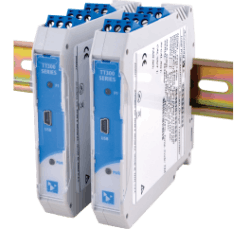Acromag’s new TT351 load cell or strain gauge signal conditioners use software to quickly select from a wide variety of sensor measurement options. A USB port simplifies setup on a Windows PC or Android mobile device with Acromag’s AgilityTM app. Software menus help users set the sensor type, bridge configuration, excitation source, filtering level, and input/output ranges. Advanced capabilities let users fine tune scaling of I/O signals, adjust excitation levels, and calibrate the bridge. Universal output supports six ranges including 4-20mA, 0-10V and ±10V. Flexible power accepts a 9-32V DC supply at the terminals and a rail power bus option can supply multiple units from a single connection or establish redundant power. The narrow 17.5mm housing mounts easily on a DIN rail. Hazardous location approvals, high noise immunity, and a -40 to 70°C operating range make these transmitters ideal for use in harsh environments.
The TT351 input circuit allows true six-wire bridge measurement and includes an adjustable bridge excitation supply (4 to 11V DC) with a remote sense feature. Sense wires ensure the programmed excitation voltage is applied at the sensor and enable lead-wire compensation. The differential input performs true ratiometric conversions for extremely stable measurements that remain accurate over time and temperature. Plus, lead break detection is inherent in the device. Three-way isolation between input, output and power increases safety and noise immunity.
Advanced signal processing capabilities, variable range input, and convenient USB programming make this instrument versatile for strain/load measurement. One model can process strain gauge, load cell, and milliVolt input signals from 1-10mV/V. Initial bridge offsets or forces can be automatically removed with null compensation, tare, and zero-balance bridge functions. An internal half-bridge can perform half- and quarter-bridge completion with precision resistor pairs or bias a floating milliVolt input signal. A custom input signal linerarizer function supports up to 25 user-defined signal breakpoints. Flexible scaling is independently adjustable for input and output. To suppress noise effects, users can set a variable digital input filter level or average several samples. Shunt calibration tools with a simulation calculator enable rescaling of the transmitter’s indicated strain by modifying software gain and/or the instrument gauge factor. To test or verify operation, a software diagnostics screen polls the unit, then displays measured and computed values.

